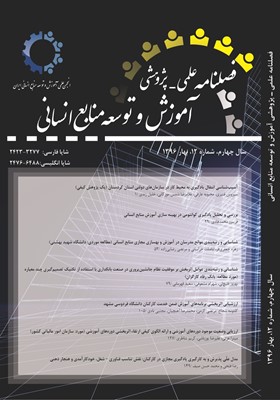شناسایی و تبیین ابعاد، مولفه¬ها و شاخص¬های توسعه شایستگی مدیران صنعت بانکداری
محورهای موضوعی :حسن عاشقی 1 , محمد قهرمانی 2 , نادرقلی قورچیان 3
1 - بانک
2 - دانشگاه شهید بهشتی
3 - استاد گروه مدیریت آموزشی، واحد علوم و تحقیقات، دانشگاه آزاد اسلامی، تهران، ایران
کلید واژه: مدیران, توسعه, مولفه¬, های شایستگی و بانکداری,
چکیده مقاله :
پژوهش حاضر با هدف شناسایی و تبیین ابعاد، مولفه ها و شاخص های توسعه شایستگی مدیران بانکی انجام شده است. برای نیل به مقصود مذکور، از رویکرد پژوهش کیفی و روش مصاحبه نیمه ساختار یافته استفاده شده است. برای تدوین چارچوب پژوهش، نخست ادبیات و پیشینه توسعه مدیران با تاکید بر شایستگی های مدیریتی مطالعه و چارچوب و پرسش های مصاحبه تدوین شد. سپس مصاحبه ها در جامعه آماری مدیران ستادی بانک توسعه تعاون و با روش نمونه گیری هدفمند اجرایی شد. جامعه مورد مطالعه، مدیران خبره بانک و نمونه آماری 21 نفر از آنان بود. ابزار گردآوری اطلاعات فرم های مصاحبه و روش تجزیه و تحلیل، تحلیل محتوا بود. یافته های پژوهش نشان داد برای توسعه شایستگی مدیران می بایست پنج بعد، بیست مولفه و صد و سی و دو شاخص مورد توجه برنامه ریزان آموزشی قرار گیرد. ابعاد پنجگانه عبارتند از: 1)بعد فکری – ارزشی، 2)بعد ارتباطی، 3)بعد فنی – تخصصی، 4)بعد مدیریتی و 5)بعد توانایی. مولفه های بیستگانه عبارتند از ارزش های عمومی، ارزش های سازمانی، بینش و نگرش، ویژگی شخصی، ارتباط فردی، ارتباط بین فردی، ارتباط بانکی، رهبری، اعتبارحرفه ای، دانش مالی – بانکی، دانش فناوری، مهارت آموزشی – پژوهشی، مدیریت خود، مدیریت دیگران، مدیریت کسب و کار، توانایی عاطفی، توانایی ذهنی، توانایی تجربی، توانایی تحصیلی و توانایی فیزیکی. شاخص های صدو سی و دوگانه در مدل نهایی آورده شده است. نتایج پژوهش حاکی از آن است برای توسعه شایستگی مدیران در حوزه پولی و بانکی، می بایست مدلی مشتمل بر یک هسته مرکزی، دربرگیرنده عناصر تشکیل دهنده شایستگی های مدیریتی و جامعه حامی توسعه مدیران که لایه دوم تاثیرگذار بر برنامه های توسعه مدیران است و ابعاد پنجگانه، مولفه های بیستگانه و شاخص-های صد و سی و دوگانه مورد توجه قرار گیرد.
The purpose of this study was to identify and explain the dimensions, components and indicators in competency development for bank managers. To achieve this goal, the qualitative research approach and semi-structured interview method have been used. To formulate the research framework, literature and the history of managerial development were developed with emphasis on study management competencies and frameworks and interview questions. The interviews were conducted in the statistical society of the managing of the tose,e taavan Bank and implemented through a targeted sampling method. The study population was bank managers and statistical sample of 21 people. The data collection tools were interview forms and analytical method, content analysis. Findings of the research showed that for the development of managers' competency, five dimensions, twenty components and one hundred and thirty-two indicators should be considered by educational planners. The five dimensions are: 1) mental -value dimension, 2) communication dimension, 3) technical - specialized dimension, 4) managerial dimension and 5) ability dimension. Twenty components include public values, organizational values, insights and attitudes, personal characteristics, individual communication, interpersonal communication, banking communication, leadership, professionalism, financial-banking knowledge, technology knowledge, educational-research skills, self-management, management of others, business management, emotional ability, mental ability, experiential ability, academic ability and physical ability. The one hundred and thirty-two indices are presented in the final model. The results of this research indicate that for competency development of managers in the field of money and banking, a model consisting of a central core should include the elements that form the competencies of management and the community supporting the development of managers, the second layer affects the managers' developmental plans, and the five dimensions, twenty components, and one hundred and thirty-two Indicators.
